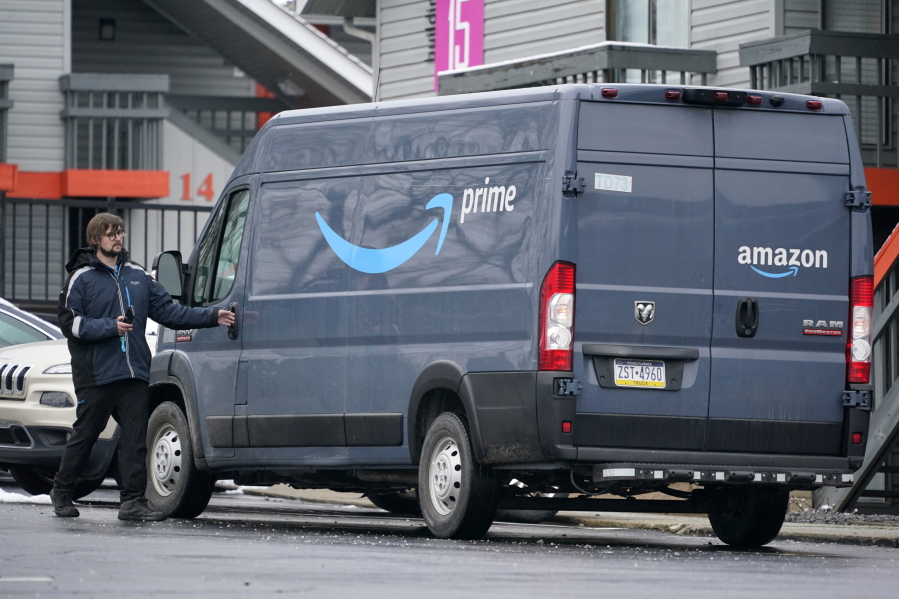SEATTLE — Delivery drivers at a Seattle-area Amazon warehouse are required to load vans at a dangerously fast pace, Washington’s Department of Labor and Industries alleged.
At Amazon’s Sumner facility, drivers have to load their vans in a “manner and timeframe” that leads to a high or very high risk of lower back injury, the department claims in a previously unpublicized citation issued in June.
The allegations follow similar pace-of-work accusations that the department levied against Amazon elsewhere in Washington regarding workers inside the warehouses. The department has accused Amazon of setting an unsafe pace of work and exposing workers to increased risk of injury from repetitive motions — such as lifting, bending and reaching — at least six times over the last two and a half years.
In some cases, the department found Amazon did not give employees enough time to rest or to use proper techniques to make the work safer. That puts employees at an increased risk for musculoskeletal disorders, or MSDs, which include injuries like sprains, strains and tears.
In Sumner, “the work pace also does not leave enough time for workers to use proper lifting form to make the work safer or take advantage of the help offered by Amazon associates to load the vans,” L&I wrote in the citation. The fast pace makes it “impractical for workers to follow Amazon’s safety training, including safe lifting methods.”
Amazon said it disagrees with the allegations in the citation and is appealing it.
Amazon and L&I have spent the past five months at trial before a judge from the Board of Industrial Insurance Appeals contesting the merits of four citations regarding Amazon warehouses in DuPont and Kent, and a delivery station in Sumner that has since closed.
Amazon has appealed all four citations, arguing its employees work at a comfortable pace, the rate of injury at its warehouses is improving, and that it has invested in new technology, equipment and work procedures to continue bringing injury rates down. During the trial, Amazon accused L&I of measuring the injury risk incorrectly.
In July, L&I issued yet another citation against Amazon accusing it of failing to create a safe work environment. This time, L&I accused Amazon of knowingly endangering workers at its Spokane fulfillment center. In the three years since the facility opened, workers there filed more than 400 workers’ compensation claims for work-related musculoskeletal disorders, L&I found, marking Spokane with the highest injury rate of any Amazon warehouse in the state.
Amazon disputed these allegations as well.
“Once again, L&I is relying on prior citations we have challenged … as a basis for alleging that we willfully exposed employees to ergonomic hazards. That is categorically false,” Amazon spokesperson Maureen Lynch Vogel said in August. “We look forward to a full and fair hearing on the citations we’ve already challenged because, the fact is, we’re making measurable progress.”
Meanwhile, federal workplace safety regulators from the Occupational Safety and Health Administration, the Department of Justice and a health and labor committee in the U.S. Senate have all opened investigations into working conditions in Amazon’s warehouses.
In Washington, L&I is finalizing a new rule that will require companies like Amazon to disclose quotas for warehouse workers and notify employees if those expectations change.
The legislation, set to go in effect in July 2024, would give L&I the authority to take action if a quota puts workers at risk. A quota would violate the Washington Industrial Safety and Health Act if it doesn’t give workers enough time to take rest breaks, go to the bathroom or access tools and equipment needed to work safely.
Amazon maintains it does not set quotas for its workers and that employees are free to take breaks as needed.
A recent study from the University of Illinois Chicago’s Center for Urban Economic Development suggested “injury and pain at Amazon are far more widespread” than previously known, according to the director of the center. Two-thirds of Amazon warehouse workers who responded to the survey said they took unpaid time off to recover from pain or exhaustion from the job.
Amazon contested the results of the survey, and maintains that the injury rate at its warehouses has improved significantly. The survey did not include responses from managers or drivers.
In its citation regarding delivery drivers at the Sumner warehouse, L&I recommended giving drivers more time to load packages from the cart into the van, as well as reducing the size and weight of bags that drivers have to lift. The department also recommended having more staff on-site to coach drivers on safe lifting techniques.
Employees clocked a Composite Lifting Index — a calculation from the National Institute for Occupational Safety and Health to measure injury risk — of 2.24 and 3.1, both higher than the low-risk threshold of 1 CLI, according to L&I.
The department issued the citation to Amazon, though the employees who were at risk of injury worked for outside delivery companies that Amazon contracts with, according to L&I. Those companies, part of Amazon’s Delivery Service Partners program, are Aslar Logistics, Total Package Logistics and Stave Delivery.
The department didn’t issue any violations to those companies because, it said, Amazon created the hazard and the independent contractors didn’t have the ability to correct it.
L&I issued a $6,000 fine with the citation. The four fines at the center of the ongoing trial between Amazon and L&I total $81,000, while the Spokane citation carried an $85,800 fine.



